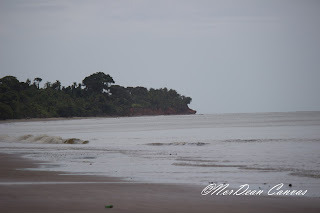Things
of old, things of new, endings, and beginnings, history and future, the
correlation of time past to time present. Where would we be, would the road not
travelled be mapped? Do we know our
history, or where we really came from?
Travel
with me as I go south along the winding roads through many towns each with a
vibrancy of their own. From San Fernando
through (some of the villages that I know) Oropouche, Ottaheiti, Dow Village,
Aripero, Rousillac, La Brea, Sobo, Vessigny, The Rubber, Vance River, Guapo
Stretch, Cochran, Gonzalves, Point Fortin, Fanny Village, Cap-de-Ville,
Chatham, Curumandel, Granville.
My
mother was born in Cedros, it is the south western most area of the
island. Her village is called
Fullerton. Granville is a village on the
way to Cedros. We went down to Cedros
and on our way back up decided to detour to Granville beach.
These
Cedros villages are fishing villages, with livestock farming and coconut
harvesting following a close second for means of earning a living. A quiet life, a simple life, a peaceful
life. I always enjoy my time there. The family is loving and giving, always with
some good country cooking to be consumed.
Yum yum!
At the
beach we walked the shore and saw ‘chip chip’ and quickly got our buckets and
sticks out the vehicle on a chip chip adventure.
Chip
chip is a small shellfish found along the tideline of Trinidadian beaches. In
1973, Shiva Naipaul, the brother of renowned author Sir V. S. Naipaul (Paul
Theroux, 1998), published the book The Chip-Chip Gatherers. The quote comes
from the inside cover of the dust jacket. In the book, he used chip-chip
gathering as a metaphor for the futility of life. Chip-chips are tiny Donax
clams (donaca) that live in the sand along the tide line and used to be eaten
throughout the Caribbean and southeastern United States. They are a delight to
watch, as they leave the sand with each passing wave and then burrow furiously
back into the sand as the wave ebbs, repeating this action with every wave. Gathering chip chip is a tiring task because
they are small each clam holding less than a gram of meat and you must move
swift with the rising tide to be able to collect them between each wave.
I
found that this beach was fed by many small tributaries. It is a very long expanse of sand, extending
for miles from end to end. From this
beach you can see the northern drilling field of our marine oil company Trinmar
a division of Petrotrin. From what I
remember, this northern field also was home to most of the compressor platforms. I am saying what I remember as my father was
head of the production department when he worked there and I myself worked for
the company four years prior to me migrating to the USA.
The
water at Granville was warm and a bit murky from the drilling and marine oil
affairs taking place some 100 miles away.
The sky was overcast and the atmosphere breezy. My brother and I walked up the beach and
turned back just shy of the tip for fear of my camera getting wet with what
looked like a fast approaching shower.
There
were many buses and maxi taxis showing up at the beach facilities, with food
and drinks in tow. Seems like time to
leave, because I do not like crowds.
Here
are a few snaps showing the beach, the rigs, the chip chip, the tributaries,
the vibe!
I hope
that you enjoy.
© 2013, Odette M. Lawrence and NorDean Canvas. All rights reserved. The use and/or duplication of this material without the express and written permission of this blog’s author and/or owner are unauthorized and strictly prohibited.
© 2013, Odette M. Lawrence and NorDean Canvas. All rights reserved. The use and/or duplication of this material without the express and written permission of this blog’s author and/or owner are unauthorized and strictly prohibited.




















No comments:
Post a Comment